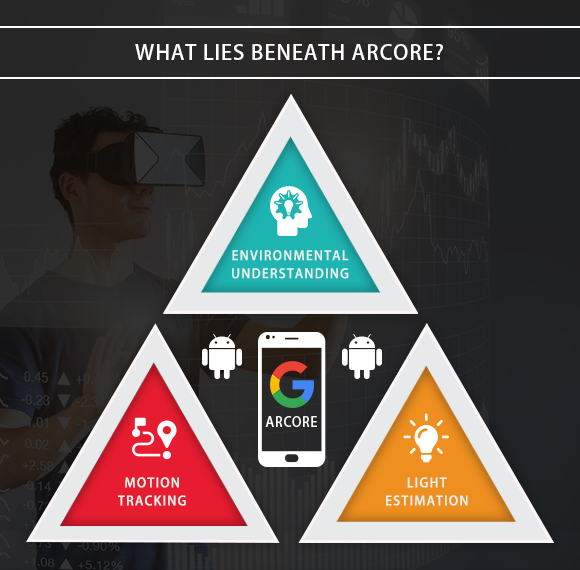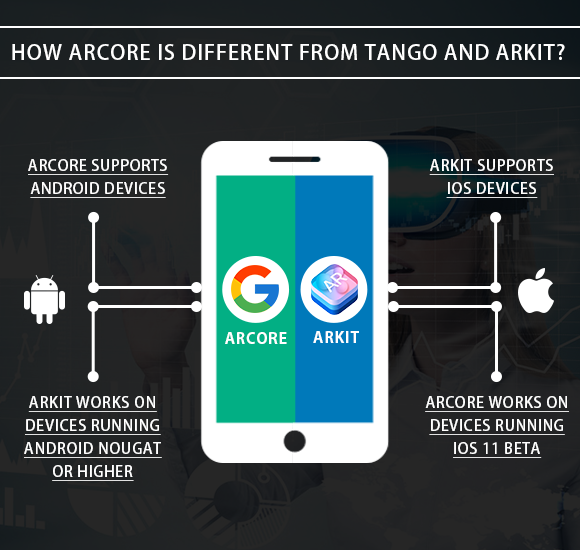Google announces ARCore. What lies beneath? How does it stack against Apple’s ARKit?
Recently, Google announced a tool that will allow developers to write AR apps for android devices. Augmented Reality (AR) is something that takes users to a different world. It helps developers to overlay digital content on top of real world.
Now, the question is – what is the big tool?
This developer tool is known as ARCore and is similar to Apple’s ARKit using which iOS developers used to make AR apps for iPhones.
What we can expect from ARCore?
Google has invested a lot in AR platform in the recent years. However, to support the AR apps – the smartphones needed special hardware and sensors.
With the launch of ARCore — we can expect that AR apps to run on existing android devices without the need of any special hardware or sensor. With this move, Google is shuttering the Tango brand. However, this doesn’t mean that Google is skirting away from its high-tech capabilities. With the launch of ARCore, we foresee that more and more devices will have in-depth sensing capabilities and it will work seamlessly with those and benefit from additional sensing capabilities.
As of now, ARCore is likely to focus on detecting horizontal planes, managing the devices motion to track and estimate light. This is obviously a cool-to-see action, as it allows digital objects to lit based on the environment.
What lies beneath ARCore?
ARCore will give a shape to Google’s augmented reality ambitions that were never possible with OEMs. This platform is less demanding than Tango in terms of the hardware needs. Most of the ARCore apps look gimmicky. However, when it comes to broader smartphone AR space — it is nothing unique. Google could hold the biggest advantage in space when it comes to the combination of AR stuff and machine learning tech.
Google is working on bringing AR to other areas through ARCore, including an experimental build of Chrome. For now, Google is racing to get ARCore on as many as devices as possible and build on Tango technologies that entices developers to get creative with Google AR ambitions.
A preview of ARCore is available for developers to try with. ARCore currently works with Samsung Galaxy S8 phones and Google Pixel. According to Google, ARCore works with Java/OpenGL and focuses on three key areas as below –
Environmental understanding – As said above, ARCore can detect horizontal surfaces using the same feature that it uses to analyze motion tracking.
Motion Tracking–ARCore can determine position and orientation of a moving phone, while the virtual objects are accurately placed.
Light estimation – ARCore allow developers to light virtual objects in ways that match their surroundings and create a more realistic experience.
The ARCore will definitely help Google become more competitive in AR space. ARCore makes it possible to create innovate AR experiences that are smooth and realistic — and function with a high level performance.
App developers are eagerly waiting to start building AR experiences based on the ARKit. Major brands are embracing this platform and are using ARCore to build a new feature for their Android apps. Companies have been experimenting withAR for years and thanks to the ARCore tool that made it possible develop large campaigns around AR.
How ARCore is different from Tango and ARKit?
The biggest difference between ARCore and Tango is the hardware requirements. Unlike the custom requirements of Tango, ARCore can run on any Android device running Nougat or higher. Tango measures the distance directly, while ARCore has to estimate the scale based on camera feed. The new SDK is likely to be based on Tango itself, and you can say that it is a more accessible version of Tango.
According to Google, ARCore is a long-term outgrowth of Tango. It also seems possible that Google will keep pushing for new and better cameras based on Tango.
ARCore and ARKit are similar to some extent. The key difference is that devices they run on i.e. ARCore supports Android devices, while ARKit supports iOS devices. ARKit works on devices running Android Nougat or higher – while ARCore works on devices running iOS 11 Beta.
What kind of apps can be created?
ARCore can be used to create stunning apps in gaming field. Though AR is a natural fit there, myriad of other apps can take advantage of ARCore. At present, there are only a few examples of AR apps. However, you can achieve a lot with ARCore, such as – live shopping experience, 3D home view, virtual reality and many more.
Developers can create apps that cater on AR for smartphones, and it has the potential to change the way we have been using our phones in daily lives. Image holding the phone up and pointing around the new place to find places of interest pop up on the map with detailed reviews.
In an interview, Google spoke about building AR enhanced web browsers for both Android and iOS devices through the most happening technology known as Visual Positioning Service (VPS) that allows AR to be scaled beyond just placing the objects on table top.
Conclusion
The bottom line is – ARCore redefines the way developers approach augmented reality. The ARCore team has been working with Google Lens team so that users use the two technologies interchangeably and have a better experience. Google ARCore will be readily available than Tango, and the future of AR apps will be confirmed in a matter of time.
Tango developers have found some interesting things to do with AR. However, the best AR apps might not come into light until the other products of Google advance.
Augmented reality offers a new way of looking at the world, regardless of the window you are looking through. Google is redesigning its tools to interpret what you see and how you see.
Please share your thoughts about ARCore and leave your comments below!
Still have your concerns?
Your concerns are legit, and we know how to deal with them. Hook us up for a discussion, no strings attached, and we will show how we can add value to your operations!

